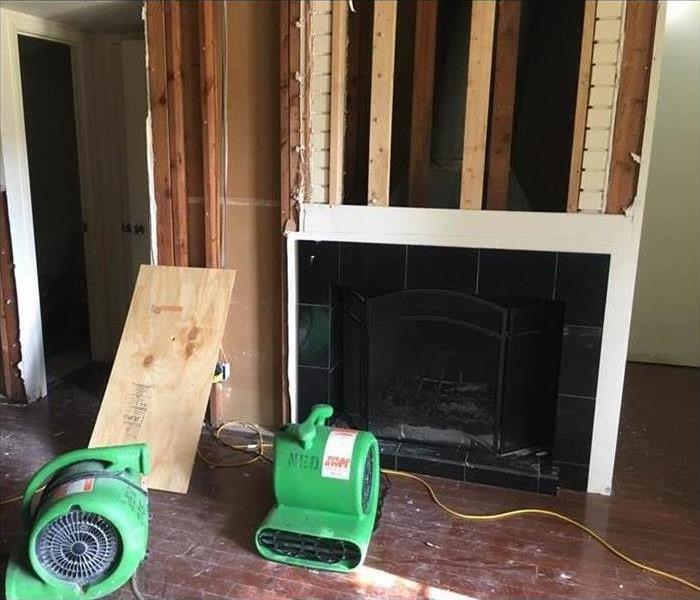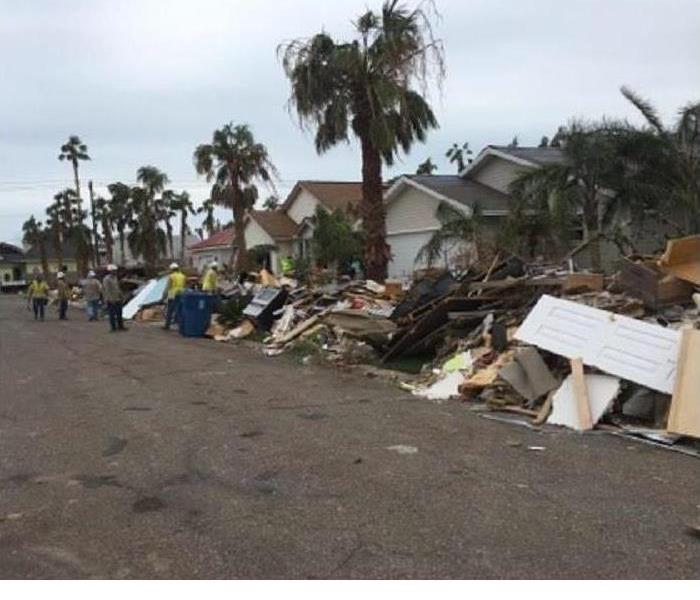Recent Storm Damage Posts
How to Prepare for Spring Storms
5/7/2024 (Permalink)
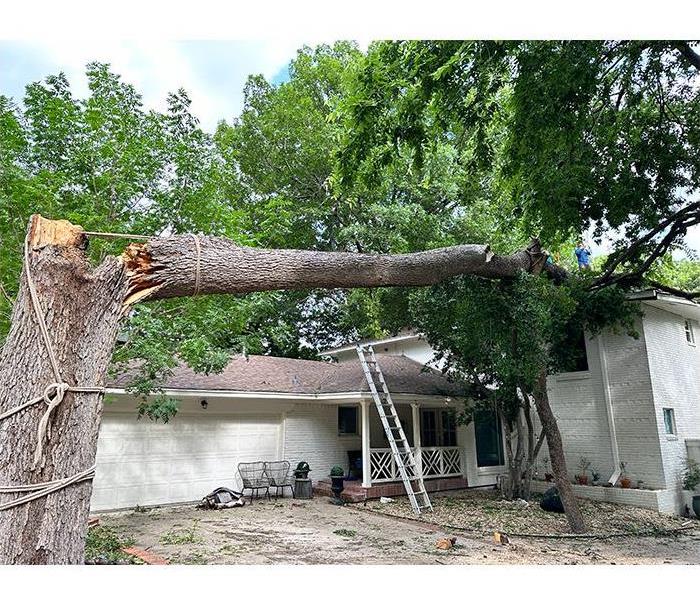 SERVPRO of Northeast Dallas was called in to remove this tree from a home in Lakewood. We repaired the roof and the interior of the home.
SERVPRO of Northeast Dallas was called in to remove this tree from a home in Lakewood. We repaired the roof and the interior of the home.
Spring in Dallas, Texas is a fantastic time for outdoor fun with loved ones, but it also brings the potential for severe storms that can wreak havoc on your home. To help you safeguard your property, we've compiled some essential tips for preparing your home for storms and handling water damage mitigation if needed.
Preparing Your Home for Summer Storms
Roof Inspection: It's crucial to ensure your roof is in top condition to withstand the elements. Schedule a professional inspection to identify any damage or signs of wear and tear. Prompt repairs can prevent water damage during storms.
Gutter Maintenance: Keep your gutters clear to prevent water from overflowing and seeping into your home. Regularly clean gutters and downspouts to avoid potential water damage.
Tree and Shrub Maintenance: Trim back any overhanging branches that could pose a threat to your home during high winds or lightning storms. This proactive measure can prevent significant damage caused by falling branches.
Secure Outdoor Furniture: Strong winds have the potential to toss around or damage outdoor furniture. Secure or store items properly to prevent them from becoming projectiles during storms.
What to Do If You Need Water Mitigation from Water Damage
Contact a Professional: In the event of water damage, it's crucial to enlist the expertise of a professional water mitigation company like SERVPRO of Northeast Dallas. We possess the necessary equipment and skills to swiftly and effectively address the damage.
Assess the Damage: Upon arrival, the water mitigation team will assess the extent of the damage and devise a comprehensive plan for remediation.
Initiate Mitigation: The mitigation process will commence, involving tasks such as water extraction, drying, and dehumidification to prevent further damage and mold growth.
Restoration: Once mitigation is complete, the restoration phase begins. This may entail repairing damaged areas, replacing materials, and restoring your home to its pre-damaged state.
While summer storms can pose a threat to your home, taking proactive steps and seeking professional assistance when needed can help minimize the impact of water damage. If you find yourself facing water damage, don't hesitate to reach out to a trusted water mitigation company like SERVPRO of Northeast Dallas for prompt and effective assistance.
What to do After a Flood
12/12/2022 (Permalink)
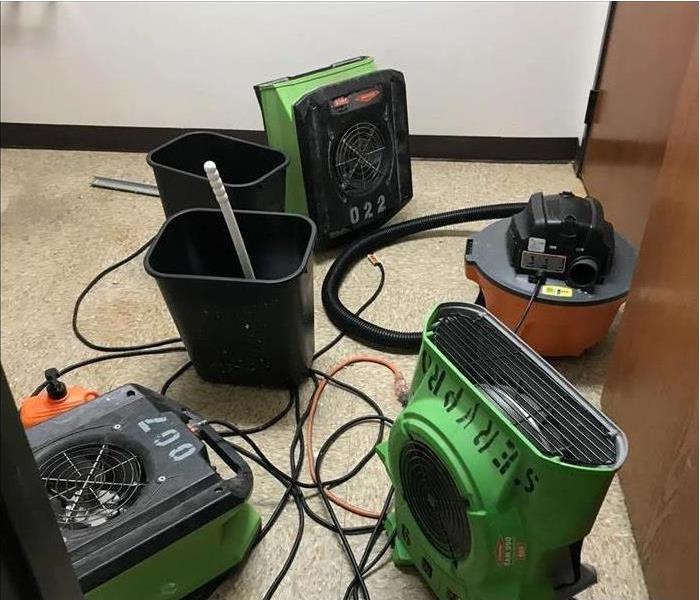 Water clean up after a storm in Hamilton Park, TX
Water clean up after a storm in Hamilton Park, TX
Post- Flood Clean Up
After a flood, your home can be damaged in several ways. You may find that the water has seeped into your walls and floors or even caused mold to grow. There are things you can do on your own and those that need to be handled by professionals. Below we’ll cover what is involved with post-flood clean up, as well as tips on getting started on the right track:
Call Restoration Professionals To Extract Standing Water
After a flood, standing water can quickly cause extensive damage to your home. You may need to extract the water before it has a chance to cause more problems. Your restoration company will be able to help with this process.
Water can lead to mold growth, which is expensive to eradicate. Getting the water out of your home as soon as possible is essential for minimizing future damage from poor air quality and any potential illnesses that may arise from prolonged exposure of water-damaged materials in your home.
Stay away from electronics
- Do not use electronics until they have been inspected by a professional.
- Do not use electronics until they have been dried out in a safe, dry environment (like a bag of rice).
- Do not use electronics until you are sure that they are safe and/or how to use them again.
Don’t attempt to fix yourself
You may be tempted to try to fix things yourself. Don't. Do not turn on the power, and do not attempt to repair any damaged appliances or furniture yourself. The electrical system could have been damaged by flood waters, so it's best to leave it untouched until you can get an electrician out there. Similarly, water damage can cause mold and mildew problems that are best left up to professionals—even if they're only minor issues at first glance.
Return home when it’s safe
After a flood, it can be difficult to know when it is safe to return home. You might feel like you're taking a risk by returning too soon and end up with more damage than if you'd waited longer. However, after being evacuated for several days or even weeks, there's a good chance that your home needs your personal touch now more than ever—especially if you've been away from your pets or plants for long periods of time.
For us to advise on when it is safe for you to return home after a flood, we need some information first:
- Where did the flooding occur?
- Was it in an area where there were severe weather warnings?
- If so, this could mean that the torrential rains caused erosion along rivers and streams nearby, thus making the ground unstable enough so as not to withstand heavy traffic (i.e., cars).
If you experience a flood, there is no need to panic. You can follow these tips to get your Hamilton Park, TX home back to normal as quickly as possible. It’s important that you act quickly and call professionals if needed.
3 Roof Repair Troubleshooting Tips
8/27/2022 (Permalink)
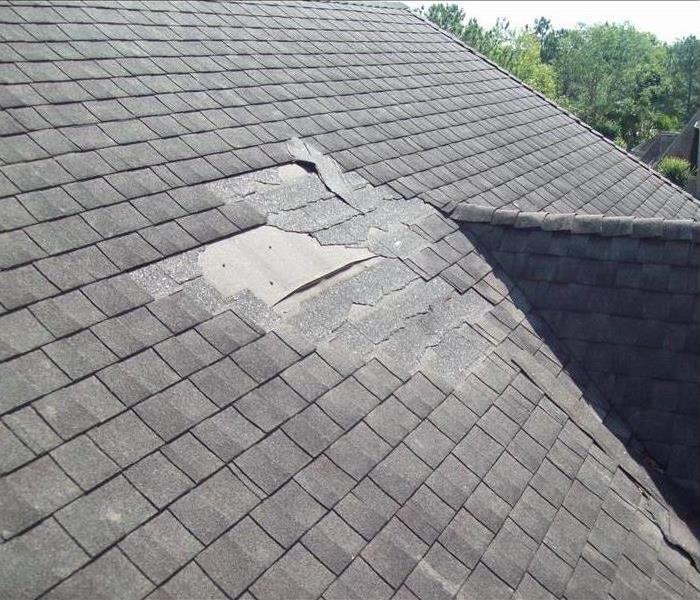 Roof damaged by wind
Roof damaged by wind
Three Types of Roof Damage You Could Be Dealing With
Whether you live on a beach with hurricanes or on a mountain with heavy winter snowstorms, your home can be at risk of sustaining wind damage. Because the roof is one of the most common places for it to happen, it is helpful to know how to quickly respond to problems there. Sometimes, you will need to call a storm damage remediation expert for help, but other times, you can fix things yourself. Here are three tips for recognizing the type of roof damage you are dealing with:
1. Check the Flashing
It is common for high winds to damage roof flashing in Wilshire Heights, TX. This is the material that protects the seams of roof fixtures such as your chimney. While you are checking the flashing, do not forget about the surrounding sealant. If it is old or cracked, you will need to replace it. Fortunately, this is an inexpensive kind of roof repair.
2. Look for Damaged Parts
A roof has several parts including vent boots, shingles and slits. Take time to carefully examine all of them. Damaged vent boots can lead to leaks, and it is easy for shingles to break and for slits to corrode. If any of this kind of roof damage occurs, you will need to buy replacement materials. This sort of roof repair can be more costly than flashing or sealant fixes, but it probably still will not break the bank.
3. Check for Holes
A puncture is one of the most expensive types of roof repairs you will encounter. If you notice a hole in your roof, moving quickly can save you money by reducing the amount of additional damage that may occur. Holes are not the kind of repair you want to make yourself though. Even if it can be costly, is better to leave this job to professionals.
If high winds damage your roof, it can be helpful to know what kind of roof repair you will need to make. Depending on the extent of the damage, you may be able to solve the problem yourself, or you made need professional assistance. Either way, acting quickly can reduce problems.
Tips on Preparing a Small Business for a Winter Storm
7/29/2022 (Permalink)
 Create a business continuity plan
Create a business continuity plan
If you own a business in a northern state, you need to prepare for the inevitable snow storm. Closing the business means lost revenues so you want to keep it running if possible, but you also want to ensure that your employees stay safe. It is important to have a plan in place so that when bad weather arrives you and your workers are prepared.
Winterize Your Building in Advance
Before winter arrives, prepare your building for the cold weather.
- Drain the water from the underground sprinkling system.
- Inspect the roof of the building for any damage and repair any issues.
- Remove dirt and debris from rain gutters and roof drains.
- Trim all trees around the building so that branches can’t fall on the building if they become loaded with ice or snow.
- Seal any gaps on the exterior of the building.
- Plan ahead for snow removal services for the parking lot and make sure you have plenty of ice melt or sand on hand to keep walkways free of ice.
Create a Business Continuity Plan
Identify any potential risks to your business, including those risks pertaining to a snow storm. Such issues as a pipe burst due to frozen pipes or loss of heat and electricity must be identified.
Evaluate the costs involved with each risk, such as business interruptions or damage to the property.
Evaluate the ways in which your team will be able to mitigate each risk. Investing in a generator, for example, can protect the business from costly repairs.
Develop a Communication Plan
If you need to shut down operations, you must have a plan for contacting employees, vendors, and contractors. Keep a current listing of phone numbers and email addresses and devise an alert system for notification. Make sure you train your employees on all emergency procedures.
Snow storms can’t be avoided if you live in Vickery Meadows, TX, but being prepared will help to protect your employees and your business.
3 Tips for Flood Safety
6/14/2022 (Permalink)
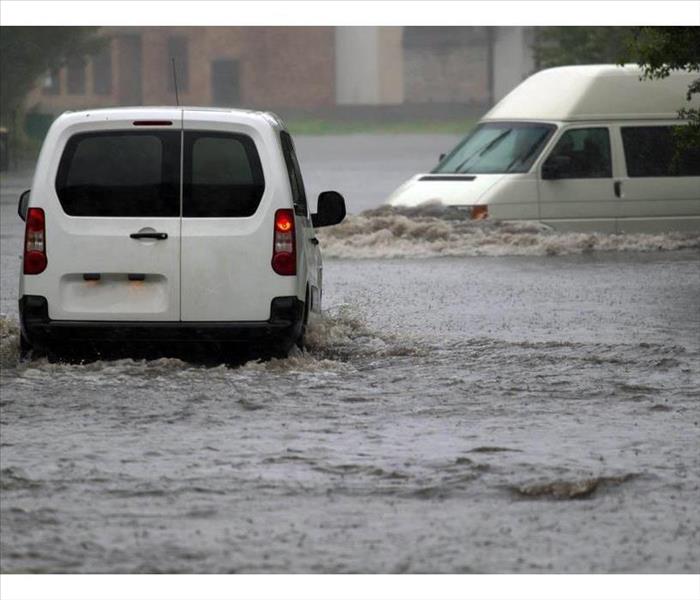 Avoid driving through a flooded street.
Avoid driving through a flooded street.
Flood Safety Tips
When powerful storms cause flooding in Hamilton Park, TX, the water that gathers on roads or invades your home can bring several dangers with it, even if the floodwaters do not look particularly dangerous at first glance. Practicing a few flood safety pointers can help keep you and your family safe until the danger passes and you can call for assistance.
1. Avoid Contact With Floodwater
When flooding occurs, the resulting rush of water can be deceiving. It is often difficult to tell how deep a flood is and how powerful the currents are. Staying away from flooded roads and out of water that pools in your yard can keep you safe, especially when the water comes from an unsanitary source, such as a creek or a clogged sewer system.
2. Do Not Drive Through Flooded Areas
Avoiding flooded areas while driving is one of the most important safety tips to keep in mind after flooding occurs. Not only could water damage your vehicle, but when the flooding grows deep enough, it can sweep your car away with little warning. If you encounter a flooded road, the safest course of action is to turn around and take an alternate route.
3. Teach Your Kids Flood Safety
Setting a good example by practicing safety during floods can teach your kids how to handle this situation calmly. Explain why they should never try to wade or swim in floodwaters and how sudden currents can cause powerful undertows. Call in a flood mitigation and restoration company to drain away water in your basement or yard and explain the advantages of calling for help after a flood.
Practicing flood safety in Hamilton Park, TX, after strong storms strike the area can help you handle the situation with more confidence. When you and your family know how to stay safe, you can weather any storm and the flooding it may bring.
How To Prevent an Ice Dam After a Winter Storm
5/10/2022 (Permalink)
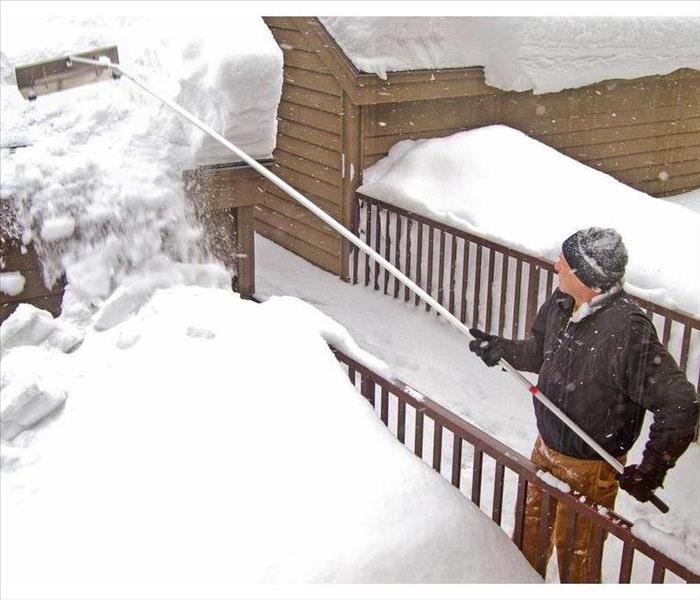 Another way to prevent a dam is to remove snow from your roof as soon as possible.
Another way to prevent a dam is to remove snow from your roof as soon as possible.
How To Avoid an Ice Dam
Snow and other severe weather in Lochwood, TX, can negatively affect your home in several ways. One thing that can cause damage is an ice dam. This occurs when snow melts and refreezes on your roof. When these form, they can make it difficult for water to drain from your roof. Over time, this water will make its way beneath the roof and into the ceiling underneath, causing deterioration and mold growth. There are a few ways that you can prevent this.
1. Keep Your Home Insulated
The cause of an ice dam forming on your roof is often heat escaping from inside the house. When the top floor or attic of your home is not properly insulated, the roof can become warm enough to melt the snow on top of it. When it eventually gets cold enough to refreeze, it forms a dam. Make sure your home is well-insulated to keep the warmth inside where it belongs.
2. Ventilate The Roof
Ice dam prevention can also be done by cooling the roof itself. Adding vents to the roof can help keep the temperature of your attic or top floor more stable. Air is able to circulate through the area, keeping it cool and reducing the heat that could melt the snow on your roof.
3. Remove Snow Buildup After a Winter Storm
Another way to prevent a dam is to remove snow from your roof as soon as possible. If it has recently stormed, you can use a snow rake to clean your roof, preventing the snow from melting and refreezing on top of your home. This can be more difficult for buildings with multiple levels, so you should only use this method if it is safe to do so.
A professional water damage remediation company can repair your home if needed, but it is a good idea to take precautions when it snows to prevent an ice dam. Keeping the temperature of your roof cool and consistent will help keep the snow from melting, and removing snow after a storm can reduce damage as well.
How To Protect Your Commercial Building From Rain Damage
4/5/2022 (Permalink)
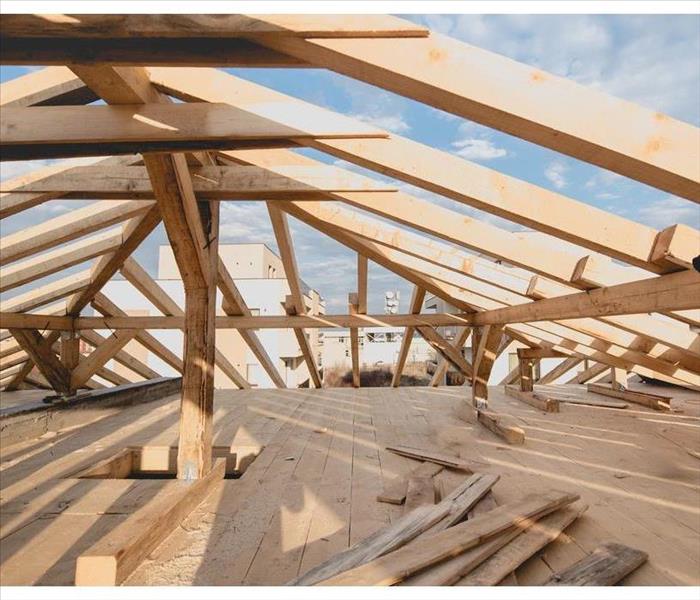 The building envelope is your commercial structure’s primary defense against storm and rain damage.
The building envelope is your commercial structure’s primary defense against storm and rain damage.
How to Prevent Rain Damage to Your Commercial Building
Rain damage can cause serious problems for your Lochwood, TX, business. Fortunately, proper maintenance can help keep the building protected and in good condition.
Prevention
To protect your commercial building from inclement weather, it is important to maintain the building envelope. The envelope is the barrier between the outdoors and indoors. An envelope is considered loose if it allows significant airflow from outside in and tight if it does not. The envelope is made up of several components:
- Roof
- Walls
- Foundation
- Windows
- Doors
Routine maintenance and regular inspections work together to keep your building's envelope strong and tight. Check for and repair cracks in the foundation and walls. Make sure the roof is leak-free and that the shingles or other roofing materials are secure. Doors and windows should be properly aligned and sealed.
Some business owners are comfortable performing inspections of the envelope themselves. Others prefer to hire a professional. Either way, it is important that the building be examined regularly to catch minor issues before they become serious problems.
Cleanup
Unfortunately, even buildings with properly maintained envelopes can suffer rain damage. If water inundates your business, it is important to act quickly to prevent structural damage and mold growth. Although black mold is the most notorious, all fungi can cause problems.
Dry the property out as quickly as possible. A certified restoration service can help with this step, but you may be able to start the process yourself if you have access to a wet/dry vacuum.
After the standing water has been removed, there will still be moisture in porous items. Fans and dehumidifiers can be used to finish drying the area. When everything is dry, professionals can help you determine what can be cleaned and salvaged and what needs to be replaced.
The building envelope is your commercial structure’s primary defense against storm and rain damage. Keeping it in good shape is the best way to protect your business from inclement weather.
Flood Damage and Storm Damage
11/20/2021 (Permalink)
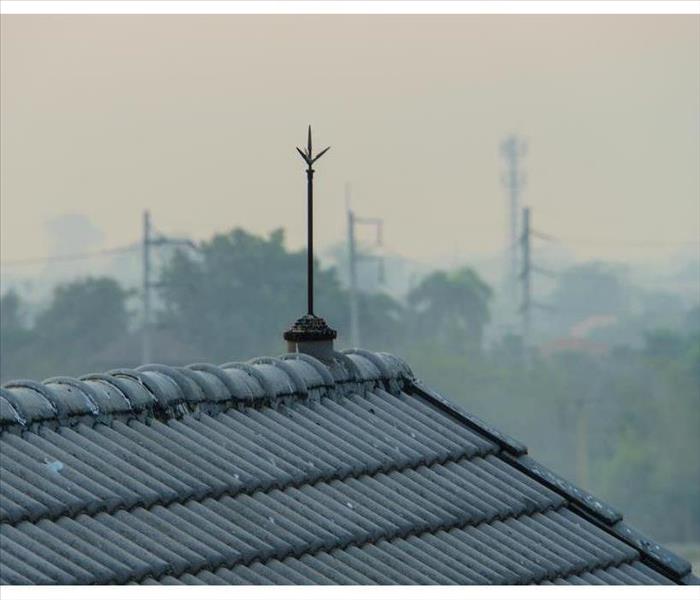 Install a lightning rod on the roof of your building.
Install a lightning rod on the roof of your building.
Preparing for Flood Damage
When looking into purchasing more weather protection for your business, it is important to recognize the types of damages you could end up with. One problem associated with storms that many people may not consider a risk at first is flooding, which can wreak havoc on your business structure and ruin your inventory. Business owners in Oak Highlands, TX, have often prepared for storm damage, but preparation for flood damage goes one step further.
Kinds of Damage
High gusts of wind and excessive rain can be caused by storms, but in addition to the types of damage that can occur under these conditions, flooding can also create these problems:
- Cause erosion in the base structure of your building
- Destroy inventory, especially electronics and paper supplies
- Create conditions for mold growth
- Carry in unsanitary chemicals and harmful debris
It is clear that these problems can present a real risk to your company, so it is important to figure out what the next steps should be.
Damage Prevention
Regardless of whether you are focusing on general storm or flood damage, there are several preventative measures you can take. Do this for general weather protection:
- Install a lightning rod on the roof of your building
- Keep more valuable inventory away from windows
- Strengthen walls with an extra layer of construction
Of course, flooding can bring about a whole new list of damage possibilities, so there are many other precautions you can exercise:
- Reconstructing the floor so it does not slope down
- Sealing shut areas where utilities enter the building
- Keeping valuable inventory above ground level
Final Step
Even though you can often carry out some of these preparatory tasks without much trouble, there is always the potential for damages when a major storm occurs. Calling a professional cleanup service after suffering flood damage is the smartest thing to do. They will assess the situation through a lens of expertise and ensure safety standards are practiced when restoring your business to its former glory.
How To Clean Sewer Backup Out of Your Bathtub
9/27/2021 (Permalink)
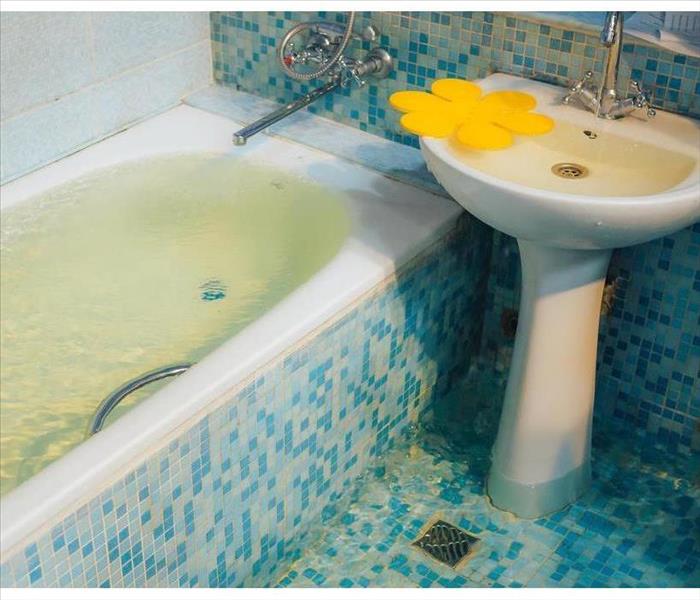 Sewer backup from a bathtub in an Urban Reserve, TX home.
Sewer backup from a bathtub in an Urban Reserve, TX home.
How to Remove Sewer Backup from a Bathtub
Your home in Urban Reserve, TX, is your haven. When everything works well and nothing goes wrong, it can be a restful place. When something like a sewer backup occurs, however, it can be stressful until the problem is fixed. There is a certain procedure for cleaning bathtub backup to ensure that it is done safely and effectively.
Who Cleans It?
If the sewer backs up into your bathtub, you first need to assess whether you can fix the problem or you need to call in the professionals. If the problem is pretty small, such as a tiny spill on the floor or one completely contained in the tub, it can probably be a DIY fix as long as you have the proper protective gear to wear. Some flooding factors, however, indicate a larger problem:
- Contamination spreading over a large area or to multiple floors
- Spill over 24 hours old
- Parts of home unable to be inhabited or used because of sewer backup
- Compromised HVAC system
The services of professional remediation experts are necessary if any of these conditions exist. They have the proper training and equipment to handle larger cleanup jobs. It is safer for everyone involved if they handle it, and your insurance company is likely to pay for the service.
How Do They Clean It?
The professional cleaning process for a backup of the sewer into your home starts with water damage remediation. They remove all excess water with industrial pumps and take damaged items and materials out of your home. After everything is removed, they sanitize the area and any salvageable item that will be returned to the space. Then they restore the parts of the structure they had to remove to make the room useful again.
Sewer backup can sometimes be cleaned by the homeowner, but most issues have to be taken care of by professionals. If you need help with the cleanup, call the experts as soon as possible to avoid further damage.
Minimize Winter Storm Damage With These 4 Cost-Saving Tips
8/27/2021 (Permalink)
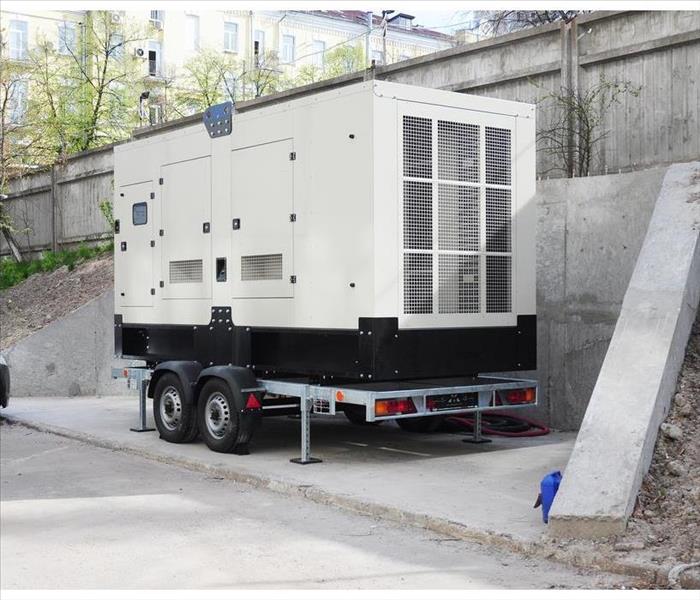 A generator can keep your business operating.
A generator can keep your business operating.
Reduce Winter Storm Damage With These 4 Money-Saving Strategies
Winters in Northeast Dallas, TX, can be severe, with heavy rains, winds and snow threatening the very infrastructure of your building on a constant basis. While there is not much you can do about a winter storm, there are steps you can take to minimize storm damage and keep your money in your pocket. Here are four cost-saving tips you can use this winter to keep damage at bay:
- Prep your building.
- Equip your building with a generator.
- Plan for snow and ice removal.
- Have a plan in place.
Prep Your Building
The best thing that you can do to minimize damage caused by a storm is to prep your building. Equip it with storm windows, replace any old weather stripping with new, have your gutters inspected and, if necessary, replaced, and shut off any outside pipes. Frozen pipes tend to cause the most structural damage during the winter, so to prevent a pipe break, make sure that no liquid is allowed to sit in it.
Invest in Backup Power
Invest in a generator, as a winter storm has the potential to knock out your power. Not only do power outages often result in burst pipes because of lack of heat, but also they can cause data loss and fried electrical equipment. A generator can keep your business operating as normal and your assets, both physical and cyber, safe.
Invest in Snow Removal
When snow and ice are allowed to build up on your building or around your structure, moisture can seep into your building and cause unnecessary structural damage. Additionally, ice is a slipping hazard, which could put you at serious liability for personal injury. By investing in routine ice and snow removal, you can minimize damage and potentially costly accidents.
Have a Plan
If a winter storm becomes too severe, you may need to follow through with a disaster plan. Make sure you have one in place and that everyone in your office knows the drill.
Protect your business against damage and losses caused by winter storms. Prep your building, have backup options, invest in snow removal and have a plan to minimize loss this winter.
How You can Respond If A Storm Puts An End To Your Flight
7/27/2021 (Permalink)
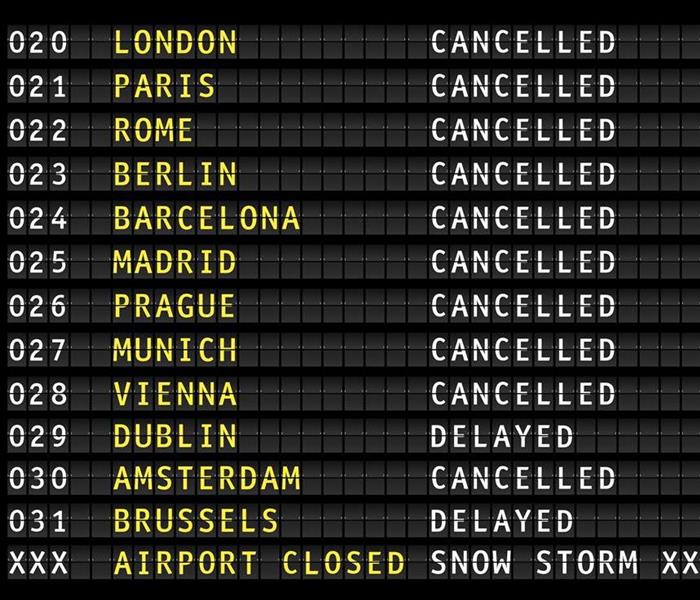 Your holiday or business trip plans don't have to be ruined because of a canceled flight.
Your holiday or business trip plans don't have to be ruined because of a canceled flight.
What to Do If Your Flight Is Canceled Due To A Storm
Whether you’re traveling from Lochwood, TX, for work or pleasure, few things are more frustrating than dealing with a delayed flight. An even worse situation is when you find out you’ve got a canceled flight. These events can put a damper in your plans, but there are effective ways you can deal with these challenges.
Make Some Plans
In most cases, you’ll have at least a few weeks to prepare before you head out on your trip. It’s important to try to avoid layovers or stops in areas where bad weather is common.
• Fly directly to your destination rather than via a place with poor weather.
• Pack as light as you can so you can reschedule your flight quickly.
• Plan to travel during times of the year when there won’t be bad weather.
• Read weather reports and try to avoid flying during storms.
Contact the Airline
If you’ve got a canceled field, it’s imperative that you get in touch with your airline right away. If you do this, you can get to the front of the line for rebooking your trip. Remember, there will be a lot of people in the same boat as you. One of the biggest storm tips you can follow is to not waste time and start booking your new flight.
Get a Hotel While You Reschedule
You might not be able to get another flight right away. Once you realize you’re stuck for the night, you should get a place to stay while you plan your next move. The faster you can get on this, the better chance you have of finding a place close to the airport that will allow you to have a good night’s rest.
A canceled flight doesn’t have to put an end to your vacation or business trip plans. Follow these simple tips to ensure you can get things back on track.
How To Get Your Business Ready for a Major Storm
6/15/2021 (Permalink)
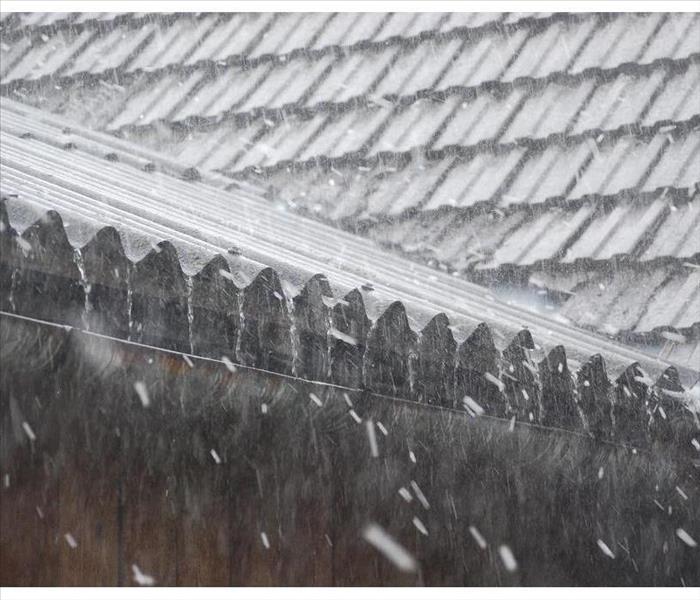 A heavy rainstorm can occur at any time.
A heavy rainstorm can occur at any time.
How To Get Your Business Ready for a Major Storm
A heavy rainstorm can occur at any time. Lightning and thunder may arrive outside your Wilshire Heights, TX, building when it is full of employees. Thunderstorms can be particularly dangerous. This type of storm features either 58-mile-per-hour winds or 1-inch hail. It can cause a variety of emergencies, including:
- Power outages
- Flash floods
- Lightning fires
It is thus important to prepare your property before the severe weather arrives. This will keep your employees safe and limit your need for storm cleanup services. Here are some tips to get you ready for the heavy rain, lightning and high winds.
Stay Informed
Your community should have an emergency alert system in place. Make sure that you have access to this system. You should also understand exactly what the different alerts mean. A severe thunderstorm watch is issued when harsh weather may occur in a particular area. A severe thunderstorm warning, meanwhile, indicates that radar or storm spotters have seen dangerous conditions nearby.
Secure Your Property
The wind that often accompanies a major rainstorm can blow away any valuable equipment you keep outside your building. Make sure you bring these items inside before the bad weather arrives.
Wind can also knock shrubs and tree branches onto the ground or into windows. Keep the plants strong and healthy by trimming them regularly and removing any damaged sections.
Be Safe
If severe weather occurs during business hours, your employees may be trapped inside during the worst parts of the storm. You should thus keep an emergency kit on the property. The kit should contain supplies the workers can use if they are stuck in the building for hours or days at a time. There should also be a first-aid kit readily available on site.
A rainstorm can cause major wind or flood damage to your property. By being proactive, you can keep employees safe and limit the harm to your premises.
Prepare Your Commercial Property for a Storm
4/9/2021 (Permalink)
Implement A Storm Preparedness Plan For Your Business
Storms can wreak havoc on commercial buildings. By implementing some sound storm preparedness plans you can reduce the risk of severe damage to your property in Vickery Meadows, TX.
1. Mitigate the Risks
Strong winds and heavy rain account for much of the damage during a storm. Before the storm hits, prepare your property to reduce the risk of extensive damage.
Bring in outdoor equipment, such as grills and lawn furniture to avoid items becoming airborne. Board up windows and glass doors so they don't shatter during the storm.
Inspect roofing materials to ensure they are secured. Fix any loose materials right away.
Trim any loose branches near the building so they don't damage the siding or break windows.
Disconnect computers and other electrical devices. Don't unplug the refrigerator, however.
Move loose items away from windows inside the building as much as possible.
2. Train Employees on Storm Procedures
Make sure all employees and visitors understand what to do in an emergency. Property management must develop work instructions to address the risks and then train workers on the procedures.
Conduct emergency drills with all employees so that they are familiar with the storm preparedness procedures. This will reduce the risk of people becoming panicked during a true emergency.
Designate evacuation exits and assign persons who are responsible to account for employees and visitors.
3. Inspect the Property After the Storm Passes
Wait until you are sure that the storm has passed before inspecting the building. If the emergency required persons to evacuate, don't allow employees to enter the building until authorities have given permission to do so.
Authorized personnel should inspect the property around the building to look for damage. They can identify issues to the structural integrity of the building and look for potential hazards that must be addressed. Call a storm restoration service if you need help with repairs.
Implement a sound storm preparedness plan to reduce the risk of damage during a storm.
How the Pros Clean up After a Leaky Roof
11/11/2020 (Permalink)
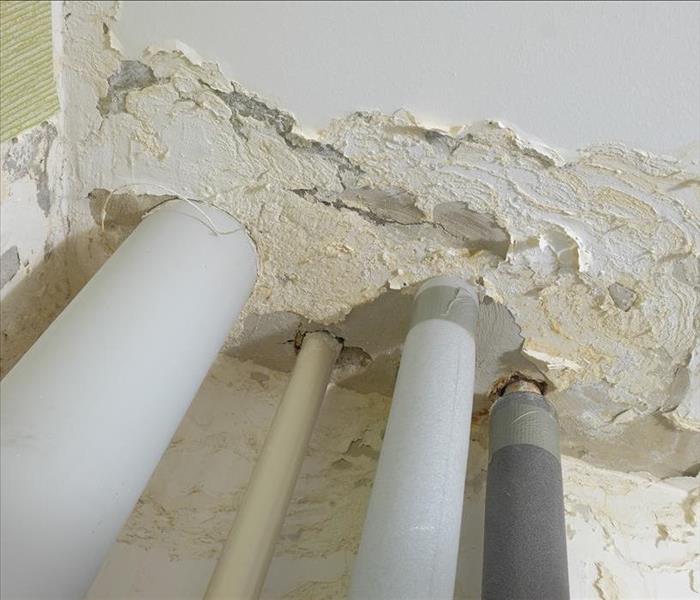 A roof leak is nothing you should ignore
A roof leak is nothing you should ignore
If You Discover A Roof Leak Make Sure To Take The Right Steps
A roof is one of the most important parts of a commercial building. A well-constructed roof will protect your building from the elements. It also provides security and safety from harm and danger. As a roof begins to wear out, leaks could occur. This can result in significant water damage to the interior. With a roof leak, even flooding can take place if you don't identify it and repair it promptly. If you discover these issues with your roof, make sure you take the right steps.
Protect Materials and Items
When your Wilshire Heights, TX, building has a roof leak, the attic or top floor will be the first to suffer damage. To prevent damage or to salvage items in these areas, make sure you do the following:
- Remove any belongings and take them to other parts of the building.
- If you can't remove certain items, cover them with a tarp or plastic.
- Tear out damaged building materials.
Remove the Water
If there is standing water in your building due to a damaged roof, you'll need to get rid of it as soon as possible. An experienced water cleanup crew has the skills and equipment to thoroughly extract all water. The team will also dry the affected area and sanitize it to ensure there is no mold growth.
Contact Your Insurance Company and a Repair Contractor
Make sure you get in touch with your insurance provider as soon as possible. Your plan may cover water damage due to roof issues. With your insurance agent, you can hire a competent contractor to repair the roof. This may include simply replacing missing shingles, or it may require the professionals to replace large portions of the roof or the entire roof.
A roof leak is nothing you should ignore. Act quickly and follow these guidelines so you can minimize the damage and prevent further water damage.
Tips for Dealing With a Canceled Flight
10/19/2020 (Permalink)
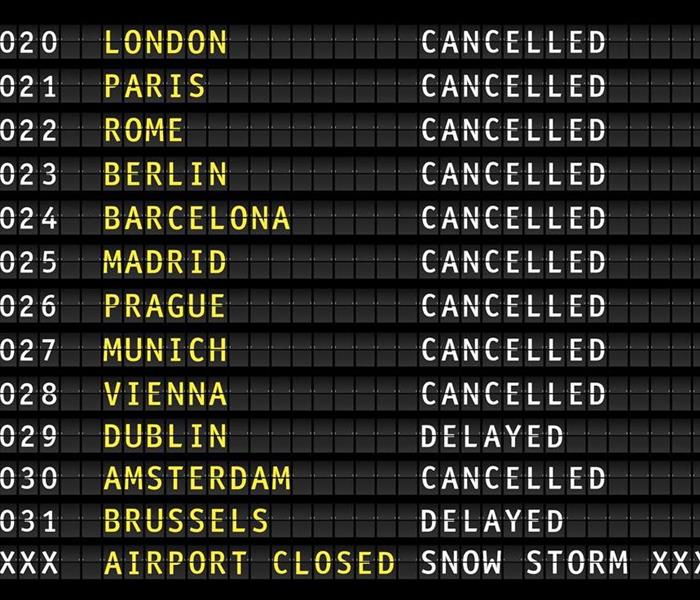 A canceled flight does not have to ruin your trip
A canceled flight does not have to ruin your trip
Below Are Some Ways To Make The Best Of The Situation
You are all set for your dream vacation when the worst-case scenario happens. Your flight to a tropical paradise has been grounded due to inclement weather. Luckily, a canceled flight does not have to ruin your trip. Below are some ways to make the best of the situation.
1. Prepare in Advance
Check the weather in Lochwood, TX, before you head out for the airport. If a storm is coming to your area, try to book an earlier or later flight.
Of course, the weather can change quickly, especially during the summer months. Don’t arrive late to the airport just because you think your flight will get delayed or grounded. The plane could still depart on time, and you could miss your flight.
2. Make a Call
Once you find out about your canceled flight, the airline will probably tell you to wait in the kiosk line. This is often a long and frustrating process. Instead, call the airline directly. This will help you re-book your flight more quickly.
3. Be Productive
Even if you are able to get a new flight, you may have some time to kill before it leaves. Take advantage of the extra hours. Contact the hotel you booked and let employees know you are going to be late.
You should also make sure your own house is safe from the storm before you leave. In addition, look up the contact information for your local emergency restoration specialists. You can call them when you return home if necessary.
4. Ask for Compensation
The airline may actually pay for any costs you incur after re-booking your canceled flight. However, you may have to ask the airline for this compensation. Research the airline's cancellation policy before you leave and understand exactly what you have to do to get reimbursed.
Nobody is happy when a flight gets grounded. However, following the above storm tips should make the situation less painful.
3 Type of Flood Barriers to Use at Your Business
9/8/2020 (Permalink)
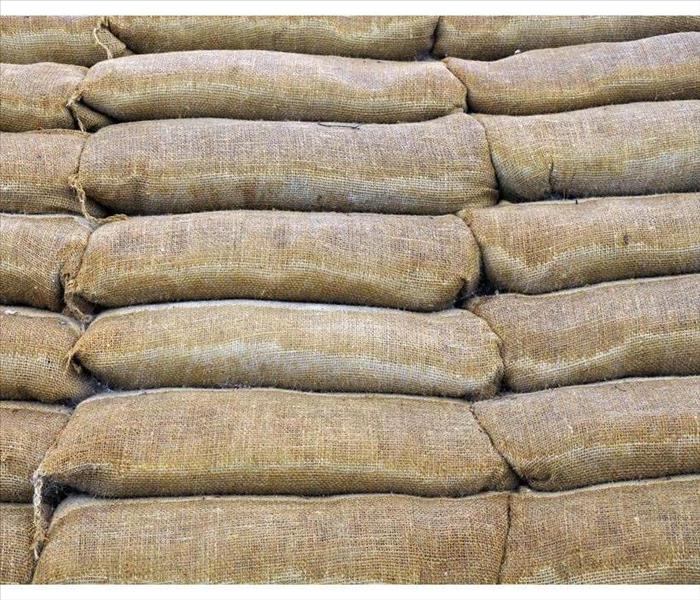 A sandbag wall can help prevent flooding in your business
A sandbag wall can help prevent flooding in your business
3 Type of Flood Barriers to Use at Your Business
When a big storm comes to the Hamilton Park, TX, area many flood damage restoration professionals recommend the use of flood barriers such as a sandbag wall to help prevent flooding. However, sandbagging isn’t the only form of barrier you may utilize. If water damage does occur, these professionals can help with cleanup and repairs.
1. Inflatable barrier
One form of many flood dams available to help protect your business is the inflatable barrier. Composed of durable fabrics, these are often weighted on the bottom to help them stay in place and can be pumped full of air to create a wall around the space you wish to protect. When the danger of flooding is over they can be deflated, and carefully folded and stored away.
2. Creative Landscaping
Another alternative to using a sandbag wall is to creatively use the landscaping around the building to direct water flow. This is a more permanent solution which may help in areas where there are frequent storms. Lawns can be sloped, and plates and soils can be chosen specifically to help absorb water. Retaining walls can also be included to help prevent erosion.
3. Water Barrier
A water barrier is similar to an inflatable barrier in that it is a collapsible tube that can be filled to create a wall. However, these barriers are filled with water, often from a garden hose, to make them heavy enough to be immobile. Once the danger of storm flooding is passed they can be safely emptied and then stored for later use.
Use of barriers such as a sandbag wall. Inflatable barriers, creative landscaping, and water barriers can help protect your business from flooding. There are many options available and you may wish to consult a professional to choose the best option for your business’s needs. If water damage does occur, a flood damage restoration service may be able to help.
Questions About Federal Disaster Aid
8/5/2020 (Permalink)
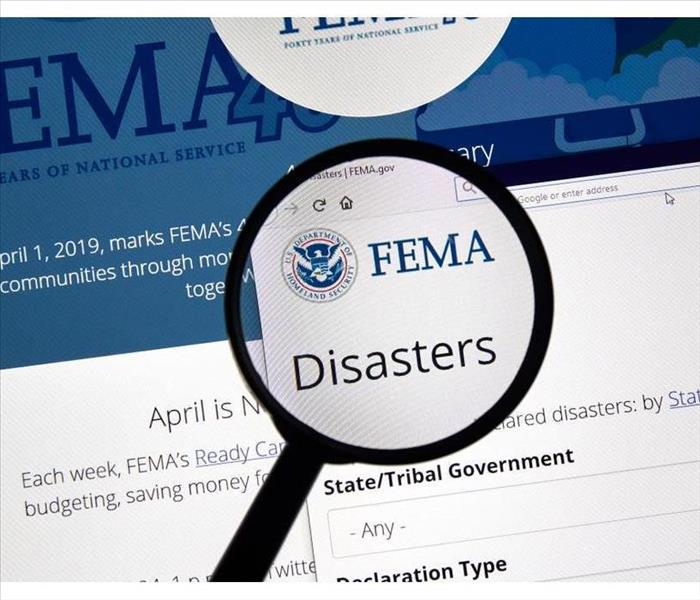 You can receive assitance from FEMA
You can receive assitance from FEMA
Common Questions About Federal Aid
After severe storms and flooding, the president can declare specific areas as disaster zones. People who live in these areas can receive assistance from FEMA. However, due to the misconceptions about disaster aid, people who qualify for assistance often do not receive it because they think they are not eligible. If you are in an area that has been declared a disaster zone and have sustained damage to your home in Vickery Meadows, TX, read on to find out some common questions about federal aid.
1. What Are the Grants For?
Disaster assistance can include money to help pay for temporary housing, home repairs, uninsured or underinsured property losses, and medical and dental expenses directly related to the storm. Other necessary expenses, such as the cost of hiring storm cleanup and restoration professionals, may also be covered under grants.
2. What Happens After You Register?
Once you have registered, you will receive a call from a FEMA home inspector to arrange a survey of the damages done to your home. This call will come through shortly after you submit your application. Your inspector will arrive at your house and show proper identification. They will not ask for money, make recommendations for contractors, or approve or deny your claim. Once your inspection is complete, you will receive a formal decision in the mail.
3. How to Apply?
You can apply for your disaster relief over the phone or online. Be sure to do so promptly because there is usually a deadline after the storm passes.
4. Who Should Apply?
Anyone who lives in a presidentially declared disaster zone and has sustained damage to their home, vehicle, or other property due to a storm should apply for a FEMA grant. This is especially true if your damaged property was not covered under an insurance policy.
If your home was damaged after a severe storm or flood, you may be eligible for federal disaster aid. Be sure to understand what grants are available, who should apply, and the claim process to smoothly get your assistance.
How Does FEMA Help After a Storm?
4/24/2020 (Permalink)
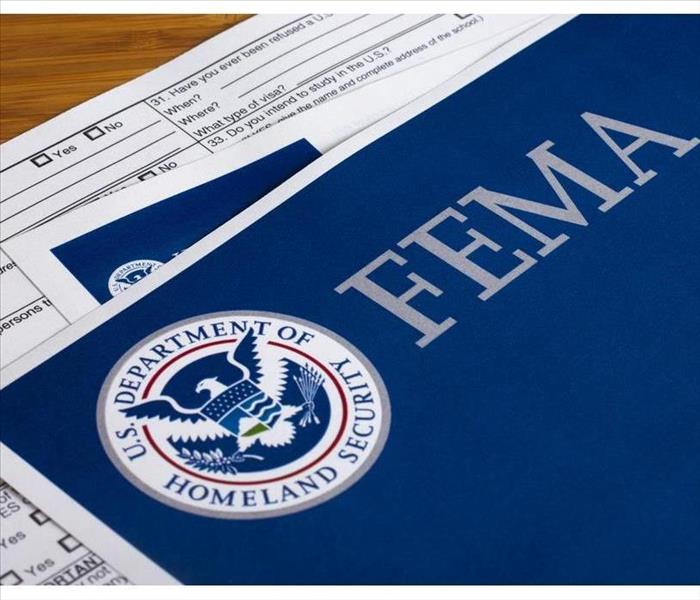 There are many ways FEMA can help out residents of Urban Reserve, TX
There are many ways FEMA can help out residents of Urban Reserve, TX
How Can FEMA Help You After a Storm?
When significant storm disasters strike Urban Reserve, TX, the Federal Emergency Management Agency may be one of the first agencies to provide shelter, assistance for basic needs, and offer help with damaged homes. How can FEMA help you after a storm? First, you should determine whether you qualify:
- Reach out for immediate assistance if you need it. The federal agency has partners providing immediate emergency assistance whether you qualify for federal assistance or not.
- Check disasterassistance.gov to determine whether you're in an area that has been declared for assistance.
- Once you've checked in online, a representative will complete an inspection/assessment of your residence.
- These officials won't ask for money or approve or deny your claim.
- If you qualify, you'll receive a check or direct deposit, as well as a letter describing the terms of receiving the money. If you don't qualify, you'll get a letter describing why you didn’t and information about appealing the decision.
The federal emergency agency offers several types of assistance for victims of major flooding and storm damage. Even if you think you won't qualify, it's a good idea to apply.
Housing Assistance
Some FEMA help is available through the Individuals and Households Program. This program offers low-interest loans administered through the Small Business Administration. Other forms of assistance from this program include temporary housing assistance, lodging expenses reimbursement, additional funding for home repair or replacement after insurance coverage, and, occasionally, housing construction financing.
Additional Types of Assistance
When necessary, the federal agency may also help with child-care expenses, medical and dental expenses, funeral and burial expenses, basic necessities (heating, clothing, furnishings,) cleaning items, and storage expenses. When it comes to hiring cleanup and reconstruction professionals, it's best to work with your insurance company.
Be Sure To Ask
There are many ways FEMA can help out residents of Urban Reserve, TX when the city qualifies for federal assistance. The most important thing to know is that you won't know whether you qualify if you don't reach out and ask.
Will My Solar Panels Be OK In a Storm?
11/13/2019 (Permalink)
 Solar panels can be big cost cutters - but they can also be a big investment
Solar panels can be big cost cutters - but they can also be a big investment
Solar panels can be big cost cutters - but they can also be a big investment. Many homeowners worry about protecting these costly devices from the risks of water, wind and storms in general. If you’re worried about panel damage after a serious storm at your Northeast Dallas, TX home, there’s good news. Keep reading to learn how your panels have been built to withstand everything from heavy storms and everything they can bring.
About Solar Energy
Typically mounted on houses in sunny regions, these panels work by harnessing photons - or particles of light - and transforming them into inexpensive electricity. The three main types of panels are:
- Monocrystalline, which incorporate a single silicon crystal
- Polycrystalline, which incorporate multiple fragments of silicon crystals
- Thin film amorphous, which are made from a variety of materials beyond silicon
Resilient Technology
Fortunately, panel damage is a rarity due to current manufacturing standards. Most panels are built to be waterproof and extremely durable, ensuring they can withstand a variety of conditions. For instance, most panels are made to endure hail falling as fast as 50 miles per hour. Panels are also usually made to withstand winds of up to 140 miles per hour, virtually guaranteeing your panels will make it through even the harshest storms.
Handling Unexpected Damage
Despite the testing and manufacturing standards your panels are exposed to, there’s always the off chance of damage. When damage does occur, it’s usually due to debris striking a panel and damaging it. Should your panels be damaged, contact your insurance company as soon as possible. Many times, the expense of repairing your panels can be covered.
Solar panels are durable and built to exacting standards. When storms are forecast, don’t lose sleep over potential panel damage. Instead, focus your attention on securing more vulnerable areas of your property before a storm, and handling things like general roof damage and flood cleanup afterward.
4 Ways to Prepare Your Business for a Snow Storm
10/24/2019 (Permalink)
 When you are expecting a storm of any kind, you should make sure to tune in to the news to keep an eye on any changes that occur
When you are expecting a storm of any kind, you should make sure to tune in to the news to keep an eye on any changes that occur
Prepare Your Business for a Snow Storm
If you are expecting a snow storm in Oak Tree Village, TX, it is important to prepare your business for this severe weather. You should take steps to keep both your building and your employees safe during this time. The following are a few ways that you can do this.
1. Watch the News
When you are expecting a storm of any kind, you should make sure to tune in to the news to keep an eye on any changes that occur. It is possible that the storm may get stronger over time or may change direction. You will need to know if this happens so you can adjust your plans accordingly.
2. Inspect for Damage
If your building is damaged, it may get worse during severe weather, so you should perform an inspection beforehand. Check for cracks in the exterior, because these can let in water that can weaken building materials or contribute to mold growth. Make sure that all of your doors and windows are properly insulated and sealed as well.
3. Keep the Building Warm
If the temperature drops during the storm, this can lead to freezing pipes. This may result in a pipe burst that can cause flooding in the building. In order to prevent this, you should keep the building warm even when you are not there. Insulate the pipes and make sure the warm air is able to circulate in the area.
4. Allow Employees to Work From Home
During a snow storm, it is generally unsafe for anyone to be driving. Because of this, it is a good idea to have your employees work from home instead of coming in to the office. Make a plan ahead of time so that everyone knows what is expected.
Even if you are well prepared, your building may still have some damage after a snow storm. If this happens, contact a cleanup and restoration service. They will be able to perform any necessary repairs to your building and belongings.
Cleaning Up After a Flood
9/12/2019 (Permalink)
 Rug damaged by water
Rug damaged by water
After a flood happens in Vickery Meadows, TX, homeowners may be faced with property losses and damage. Unlike a pipe leak, which is relatively clean water, the cleaning requirements for floodwaters are different. Along with potential black water in the mix, there can also be debris and loosened materials to watch for.
Assessing the Damage
Anything the flood waters touch will need to be addressed. If the flooding is overwhelming, a flood clean professional help you address the problem and provide services to get your home looking “Like it never even happened.” During an initial inspection, in addition to checking flooring and walls, check the following for any contact with the waters:
- Clothing
- Furniture
- Carpet
- Kitchen utensils, plates, cups, etc.
- Appliances
- Mattresses
- Toys
While some of these may be able to be cleaned, such as appliances and furniture, some of them should be thrown away. Things like mattresses and stuffed animals can be difficult to completely clean. If a rug has been saturated more than 24 hours, it may need to be tossed. Any clothes, rugs and furniture should immediately be removed and set out to dry before cleaning.
A Thorough Clean
One of the main cleaning requirements for flood waters is a good flood disinfectant. It will not only eliminate bacteria, stains and odors but also help reduce the potential for mold to grow. Once any wet items have been dried, usually for at least 48 hours, the cleaning process can start. Be sure to clean anything that has been in contact with water and remember to take safety precautions during the process, such as:
- Wear disposable gloves and clothing.
- Avoid touching the face or eyes.
- Refresh cleaning solution when it becomes cloudy.
- Thoroughly wash hands after cleaning.
While cleaning requirements may feel overwhelming on top of all the other stresses from the flooding itself, it’s important to ensure everything is clean. That will ensure any mold or bacteria is stopped in its tracks before becoming an issue down the road.
The Essentials of Your Business's First Aid Kit
8/15/2019 (Permalink)
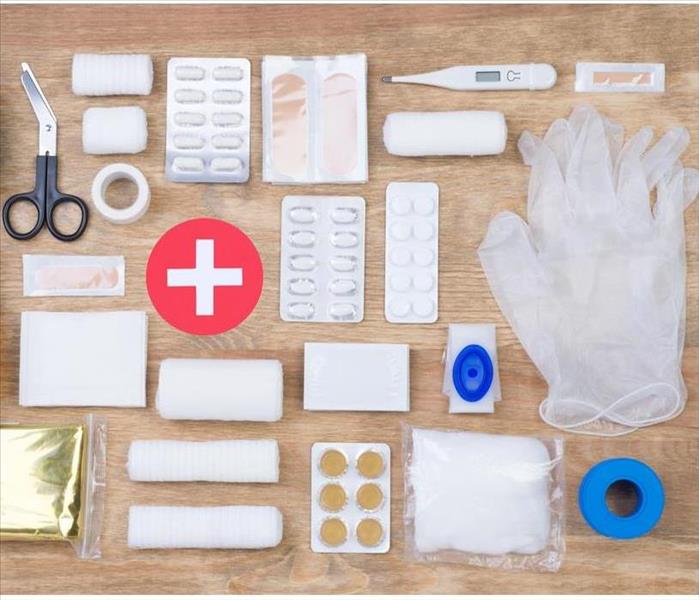 Items in a first aid kit
Items in a first aid kit
Items That Every First Aid Kit Should Have
From paper cuts to falls to natural disasters, such as devastating storms or floods, you do not want to think about these instances as a business owner in Lochwood, TX. However, if you have two or more employees, a first aid kit is required by the federal government. The Occupational Safety and Health Administration expects a business to maintain a certain amount of supplies in case of any medical issues or emergencies, and the size and type of the kit depend on the company. The following list enumerates the items that should be in every first aid kit:
1. Bandages
Regular gauze pads
Two large gauze pads
Band-aids
Gauze roller bandage
Two triangular bandages
2. Tweezers
3. Blanket
4. Adhesive tape
5. Latex gloves
6. Elastic wraps
7. Splint
8. Moistened antiseptic towelettes for cleaning wounds
9. CPR equipment to include resuscitation mask, airway or pocket mask
10. Scissors — preferably a bandage scissors
11. Directions for requesting emergency assistance
This is the minimum requirement. There are several websites which sell pre-stocked kits in various sizes.
Restock any supplies as needed to keep the inventory current. Keep a checklist in the first aid kit and make notes each time an item is depleted. Also, keep track of anything that has an expiration date. Once the date has passed, throw the item away in the proper manner. Although bandages may expire, they can always be used in an emergency to stop bleeding.
OSHA states larger businesses need multiple first aid kits. For those industries which do not have an in-house clinic, business owners are encouraged to have employees take classes in basic first aid, Cardiopulmonary Resuscitation and Automated External Defibrillators. The American Red Cross has several classes and will also come to your office for on-site training. A storm damage restoration specialist can give you the information to make the best decision on what kind of emergency kit your office needs.
In a Flood, Protect Yourself First
7/8/2019 (Permalink)
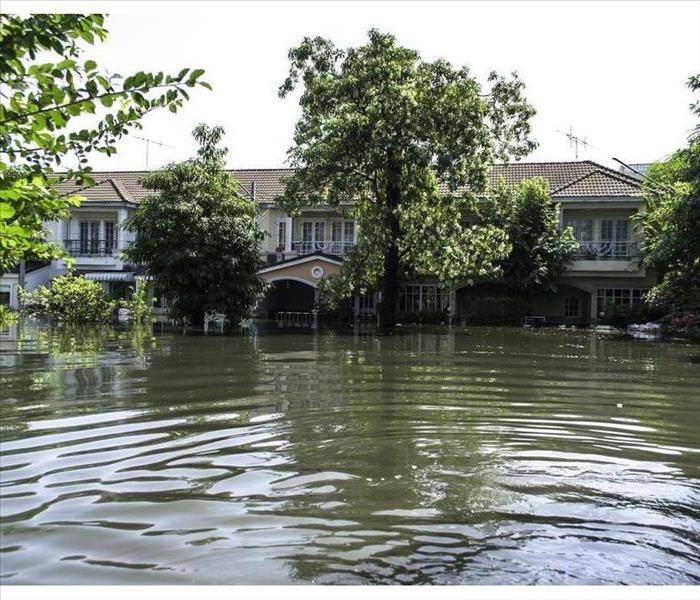 Flooded home in Oak Highlands, TX
Flooded home in Oak Highlands, TX
When the flood water runs high in Oak Highlands, TX, the most critical decisions you can make are what not to do. Avoid certain pitfalls and you can make it through the disaster with what's important.
Don't Stay Behind
You may feel tempted to sit tight and ride out the storm, but this is not in your best interest. Especially if your are receiving severe flood warnings, evacuate to a shelter or stay the night in a hotel. The well-being of you and your family are more important than your pride or property. Even if you did stay, there would be nothing you could do to prevent damage. You might end up in a situation where you need to be rescued from your flooded home.
Don't Touch the Water
Flood water can be contaminated with sewage and debris, so you should avoid contact with it whenever possible. It is especially crucial not to get it on your hands or face. If you need to get something done in a flooded area, it may be safer to hire water damage remediation specialists to handle it so you can avoid any accidents. Personal protective equipment can reduce your risk, such as:
- tall, rubber boots
- rain pants or waders
- waterproof gloves
Don't Jump the Gun
Try not to shell out any cash until you're sure of your situation and know all of your options. There are federal and state emergency funds that can help with temporary housing or water damage repairs. It is also possible to apply for a grant from FEMA if your home sits within a declared disaster area. Don't buy any replacement furniture or appliances until all your repairs are finished, just in case things don't go as planned.
It can be tough to think about your home and belongings getting ravaged by flood water, but you need to prioritize health and safety when a storm hits. Taking your time and thinking things through can save you a lot of headaches later. Doing less may actually save you more!
How To Prepare Your Business for a Flood
5/8/2019 (Permalink)
 Review your insurance policy and find out what costs your policy will cover prior to a flood
Review your insurance policy and find out what costs your policy will cover prior to a flood
How To Prepare Your Business for a Flood
Flooding can occur with little warning, and if you haven’t prepared, it could be time-consuming to restore your business in Northeast Dallas, TX. Knowing how to prepare your business for a flood can make you feel more confident about handling a disaster of any kind.
1. Backup Important Documents
After a flood, it’s often necessary to access certain documents, and not being able to quickly and easily access what you need when you need can slow down the restoration process. In addition to storing your documents in a water-resistant container that is high off of the ground, having extra copies of your documents can also be helpful. Many business owners choose to make electronic copies and paper copies to ensure that important information is not lost.
2. Check Your Insurance Policy
Restoration is often necessary after flooding, but having to put a project on hold because of the cost can be a major setback. It can be useful to review your insurance policy and find out what costs your policy will cover prior to a flood. Additionally, knowing what resources are available to business owners in your area after a disaster can give you a better idea of what costs you might be responsible for as the owner of your business.
3. Contact a Mitigation and Restoration Company Before Damage Occurs
If you know that your area is likely to sustain any type of damage from a flood, especially if severe damage such as black water damage is likely, it can be useful to contact flood damage restoration experts before your property is affected. After a disaster, you may feel as if you don’t have the time to research a company. However, by contacting professionals before a flood, you can ask questions without feeling stressed or rushed.
By preparing for flooding, you can help to protect your business from major damage. As you prepare, it can be helpful to backup documents, review your insurance policy and contact a restoration company prior to a flood.
Tips for Cleaning Your Crawlspace After a Flood
4/25/2019 (Permalink)
 SERVPRO has a well equipped team to respond immediately to your need.
SERVPRO has a well equipped team to respond immediately to your need.
A home flood can occur any time there is a storm. While there are things you can do to protect your home during storm season in Oak Tree Village, TX, floodwater may still get in. It’s important to mitigate the damage not only in the spaces you can see but also in the spaces that are not readily visible. You should always check your crawlspace for flooding after a heavy rain.
Appropriate Safety Precautions
There are several safety precautions to take when you know your home has storm damage. Anyone who enters standing water should wear proper protective gear:
• Rubber boots
• Heavy gloves
• Face mask
• Protective coveralls
You should also turn off the electricity to reduce the risk of shock. Use good judgment -- if you think any part of your home may be unsafe, stay elsewhere. Leave wading through floodwater in your crawlspace to the technicians from the flood restoration company that you hire to mitigate the damage.
Accurate Documentation
You should report your home flood to your insurance company, but an adjuster may not be able to make it to your house quickly if there are a lot of problems in the area due to the storm. To capture the most accurate evidence of the damage, it’s a good idea to take pictures or video of the flood’s impact on the crawlspace and other affected areas. This can be valuable when you are filing your claim.
Thorough Cleanup
Ideally, your sump pump will kick in when the water in your crawlspace starts to rise, so that should take care of a lot of the major extraction. The area must be completely dried and disinfected before the job is done, though. A thorough cleanup helps prevent mold growth and the subsequent damage it can cause to the structure of your home.
Home flood cleanup must cover both the areas you can see and those you cannot see. Don’t forget spaces such as your crawlspace when assessing damage.
Why You Need to Call a Professional Restoration Company to Repair Your Home After a Storm
2/18/2019 (Permalink)
 If you have storm damage, call SERVPRO of Northeast Dallas
If you have storm damage, call SERVPRO of Northeast Dallas
Storm Damage Comes in Many Forms
Recovering after a storm is always difficult. You have to deal with repairing all the storm damage.
Hurricane damage
Usually comes in the form of wind damage, river flooding, roof damage, roof leaks, and wind damage to your home. Trees can fall on your roof, and you may need roof repairs.
Ice Dams
Winter storms can bring ice damage, such as ice dams or ice damming. Ice damming is when ice builds up on your roof and in your gutters. This prevents snow from draining. This leads to roof damage such as roof leaks. You’ll need roof repairs for this too. Ice dams are the most common form of ice damage, together with frozen pipes.
Hail Damage
Hail damage is another common type of winter storm damage. If there is a lot of snow, it may melt and cause river flooding or just a lot of flooding from ground water. If there is flooding, you will need flood pumps to pump out all that flood water and ground water.
Your first step when returning home is looking after yourself. Make sure that you do not get injured by broken glass, exposed power lines, or other sharp and dangerous objects. If there is roof damage, do not go on the roof yourself to inspect it. If there is flood water or a lot of ground water in your basement, make sure it is not contaminated before you touch it. Also, if there is flooding, you need to turn off any electrical circuits before touching the flood water, because you do not want the ground water to have an electrical current.
Next, you should document the evidence. Whether you suffered from hurricane damage, ice damage, wind damage, storm damage, flooding, river flooding, hail damage, ice damming, roof damage, roof leaks, or any other kind of damage, documenting the damage is a good way to make sure that you get the compensation you deserve from the insurance companies.
A very important step to take is to call a professional restoration company to do your storm remediation. You can not do the storm remediation. You do not have the equipment that is necessary, nor the expertise. You do not know how to do roof repairs or water restoration. You do not know how to repair frozen pipes or roof leaks.
The first thing that the restoration company will do is stop any further damage from occurring and cleaning up any damage that is already there. For example, if there was flooding or river flooding, the storm restoration company will use flood pumps to start the water restoration process.
Next, they will start the home restoration process. This means that if anything is damaged and can not be repaired, they will replace it. Some things do not need to be entirely replaced, and replacing parts of them may be sufficient. For example, if there is roof damage caused by hail damage or hurricane damage, or if there are frozen pipes that have burst, then they will do a roof repair job and repair whatever they can. They will then replace whatever they can not repair.
What to Know About Black Water
2/13/2019 (Permalink)
 In many cases your insurance may cover the cost of restoration
In many cases your insurance may cover the cost of restoration
When it comes to dealing with flood water in Dallas, TX, it's important to know that this type of water often falls into the black category. This can become a factor in many cleanup operations. It is important to understand where the water comes from and what to do if flooding occurs in your business.
Where Black Water Comes From
Contaminated water, otherwise known as black water, is any water that may have come in contact with fecal matter. This may include
- Sewer water
- Water from fields
- Toilet backup
- River run off
Flooding falls into the black category because often there is no way to tell what it has come into contact with. In most cases, it is best to assume it has been contaminated and follow the proper sanitation procedures.
What To Do If Flooding Occurs
If you're busy with storm damage or flood water, it’s important to conduct any repairs necessary as quickly as possible. Doing so can help prevent further damage and may also help when it comes time to talk to your insurance. Since flooding is considered to be contaminated water, it's important to remember to sanitize the damaged area as well as to clean the zone.
How Your Insurance May Help
Depending on your policy your commercial insurance may cover the costs of cleanup and repairs related to flooding. They may even recommend a flood restoration service who can help with every step of the process. If you have questions about what exactly is covered by your policy, it's important to talk to your insurance agent.
Understanding that flood water falls into the black category can help you take proper sanitation measures when it comes time to clean up. Most experts recommend thoroughly drying the area, and then following recommended sanitation practices. In many cases, your insurance may cover the cost of restoration. If you have any questions, a professional may be able to help.
Does Your Business Need Flood Insurance?
12/20/2018 (Permalink)
A flood occurs when water covers at least two acres of land that is typically dry and affects at least two properties. Floods are caused by water from bodies or courses of water. Most standard commercial insurance policies do not include coverage for flood damage. Here are three factors to consider when determining whether your business needs flood insurance.
- The property is situated in an area with a high flood risk. If you own a commercial property in an area that is prone to flooding, it is a good idea to protect your investment with both commercial and flood policies. If you are unsure whether a property is located in a flood zone, refer to a flood map. Keep in mind that businesses on lower floors of buildings in these areas run the greatest risk of flooding.
- Your commercial insurance policy does not have flood endorsements or riders. Commercial policies tend to cover general damage that results from storms, but do not cover damage caused by flooding. Specialized flood policies, on the other hand, typically do not cover property outside the building itself, such as the grounds or septic system. You may want to consider a policy from the National Flood Insurance Program or a private insurer and add comprehensive commercial coverage that will protect your property from as many risks as possible.
- The mortgage on the property is from a federally-regulated or insured lender. The government requires owners of properties located in flood zones to purchase and maintain flood coverage. Contact an insurance agent that specializes in providing this type of insurance.
If one or more of these factors are true of your commercial property in Northeast Dallas, you should strongly consider obtaining flood insurance. If your property sustains flood damage or water damage more generally, contact a commercial damage restoration firm as soon as possible.
4 Alternatives to Sand Bags You Should Know About
10/19/2018 (Permalink)
If you have to rely on sandbagging to protect your commercial building in Dallas,TX, you may be ready for a quicker solution. A sand bag, after all, is only effective when you have enough warning to put it in place. The sheer number of sand bags needed to protect a space is part of what makes it impractical at times. What happens when a surprise storm strikes your area? Often, you end up with damage that can only be repaired by a commercial water damage remediation expert. If you use one of the following alternatives, you may be ready for a storm no matter when it shows up.
1. QuickDam
Not all flood dams have to be high tech or filled with sand. The QuickDam is a fabric product that can be placed around your property to absorb storm water. The 5-foot long barrier only stands a little over 3 inches high, so you may want to stack the product for even more protection. When water hits the barrier, it gets absorbed into the swelling barrier.
2. HydraBarrier
HydraBarrier helps protect against flood damage by using water. A 6-foot long tube is filled with water to create a dam-like barrier around a property. While it may seem like this could be a time consuming option, it reportedly only takes two minutes to fill up.
3. AquaDam
The AquaDam is a larger scale version of the HydraBarrier. It can be filled with sand or water. Many users found that it could be put in place 10 times faster than your typical sand bag.
4. Earth Shelters
If you want a permanent flood protection solution, you could consider building an earth shelter around your property. This dike-like design could direct water away from your foundation. It may even help shelter your building from standing water.
Finding the perfect sand bag alternative for your commercial building may take time. However, the time you put into it is worth it when you find a solution that protects your space from flooding.
A Guide for Sump Pump Maintenance
9/15/2018 (Permalink)
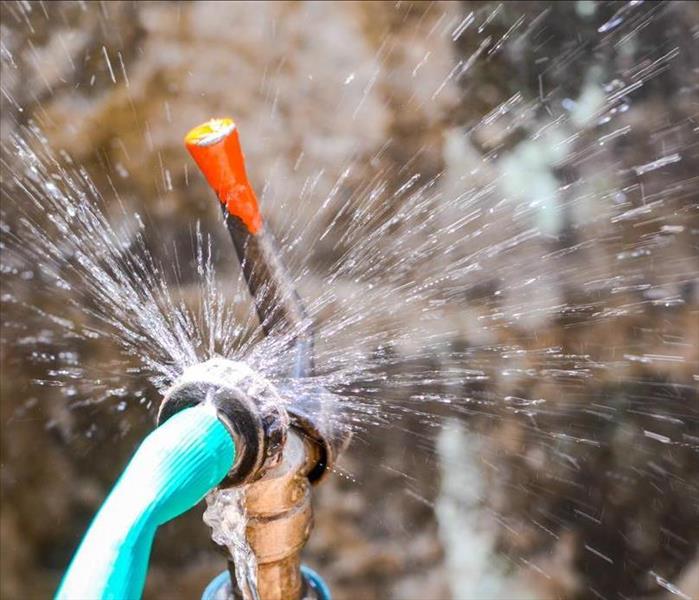 It is crucial to know when you need to call for a professionals help and when you can handle the maintenance on your own.
It is crucial to know when you need to call for a professionals help and when you can handle the maintenance on your own.
When you live in Northeast Dallas, Texas you may find that owning and maintaining a sump pump on your property is a good step for mitigating potential water damage. However, simply installing a pump isn’t always enough.
Proper pump maintenance can also be important when it comes to protecting your home from water damage.
What Is a Sump Pump
The standard use of a sump pump is to keep water from accumulating in or around your home in order to help prevent costly damage that may arise from standing water. In most cases these devices are used in homes built in areas that experience frequent storms, wet climates, or frequent accumulation of water in areas such as a basement.
Some Steps for Maintenance
If you have or are considering installing a pump to combat accumulating water, it’s important to perform regular maintenance. Some steps you may want to take include:
- Inspecting your pump for clogged screens or debris in the intake
- Inspecting the discharge pipe for clogs, gravel, mud or other debris that can affect operation
- Using a GFCI plug outlet for your machine
- Inspecting the cord for wear and tear that could create problems
- When in Doubt Ask for Help
If you feel your pump isn’t working properly, or that you may have too much water for it to handle, it may be time to call a professional for help. They may be able to tell you if there’s something wrong with your pump as well as help identify any issues that may be leading to the excess water. In the event of damage to your property you may want to speak with a water damage professional as well.
When it comes to protecting your home from water damage in Northeast Dallas, Texas proper pump maintenance is just as important as having a sump pump installed. Keeping your pump maintained can help ensure it’s in operation when you need it. Remember, if you think there’s a problem with your pump or have more water than normal, it may be time to call a professional.
First Steps for Flood Damage
7/21/2018 (Permalink)
When you have flood damage in Northeast Dallas, TX, it's hard to know where to start. You probably already called professionals to help with water removal, but you may be looking for storm tips on how to cleanup storm damage in your home and how to save your personal items. You can increase your chance of saving materials by starting the cleanup while you wait for help.
Safety First.
One of the most important storm tips is to be safe before you do any cleaning. Here is a quick list of things to watch out for when you are cleaning up in a flooded area:
• Be cautious about electrical hazards. Make sure to shut down electricity before walking in wet areas. Don't use appliances and lamps that have been wet, and don't use your vacuum to remove water.
• Use protective gear. Stay out of "gray" and "black water" as much as possible. Be sure to wear goggles, gloves, and waterproof boots to protect yourself while cleaning.
• Stay out of rooms with bulging ceilings. Don't use lights or ceiling fans on a sagging ceiling.
• Step carefully and deliberately. The excess water increases the risk for slipping and falling.
Cleaning Tips.
Once you have taken precautions to be safe, you can start cleaning. Here are some storm tips to prioritize the initial cleanup:
• Take the first steps to dry fabric items. Hang rugs and prop upholstery.
• Wipe wooden furniture with rags. Place blocks or aluminum foil between wooden legs and the ground.
• Paper and fabric items with colorful prints may transfer dyes to your carpet permanently if left for too long. Be sure to pick up those items from wet floors.
• Remove all smaller items from floors so professionals can start cleaning carpets as soon as they arrive.
• Help remove excess water by wiping it with rags or mopping.
• If you can safely run electricity, run your air conditioner to help start the drying process.
Professionals will use specialized equipment to complete the water removal and drying process. They are trained to determine what can be saved and how to each item appropriately based on the material and type of water exposure.
For more information, please visit us at http://www.SERVPROnortheastdallas.com/.
4 Ways To Prepare Your Home for a Storm
4/6/2018 (Permalink)
If you live in an area known to be vulnerable to flooding, such as Northeast Dallas, TX, it’s important to educate yourself about the risks ahead of time so that you’re prepared for the worst. For your personal safety it is critical to do the following:
• Have an emergency preparedness kit in your home
• Know where emergency shelters are located
• Understand basic safety rules for navigating flood water
• Evacuate when instructed to do so
Flooding can also cause a lot of water damage to personal property, but you can often minimize the harm done by preparing your home in advance. Here are four ways to prepare your home for a severe storm expected to cause flooding.
1. Move Furniture and Electronics to Upper Floors
If the lower stories of your home are in danger of being inundated with flood water, move electronics, important documents and valuable furniture to an upper story. If you have any furniture outside, this should also be moved indoors where it is less likely to be swept away. If you are already in a flooded building, do not touch any electrical devices while standing in water or you could be electrocuted.
2. Turn Off Gas and Electricity
If you have access to a main switch or valve to turn off your gas and electricity, you should do this to avoid any fires or explosions in your home during the flood. If you have any fuel tanks, these should be anchored.
3. Clean Gutters and Downspouts
Make sure your home’s drainage systems are clear. This will help to ensure rainwater can be directed away from your home.
4. Waterproof Your Basement
You won’t have time to do it at the last minute, but if you live in an area that experiences flooding, it’s a good idea to waterproof your basement. This can be done by painting a waterproofing sealant available in Northeast Dallas, TX, directly to the concrete. Installing a battery-powered sump pump that kicks in if there’s a power failure is also a good idea.
You can prepare your home for a storm so that the damage done by flood water is minimized. Follow these basic steps to protect your property.
For more information, please visit us athttp://www.SERVPROnortheastdallas.com.
Cleaning Up After a Leaking Roof
3/14/2018 (Permalink)
Water stains in dropped ceilings, tracking down the wall or dripping in a hallway are all signs that your commercial building has a roof leak. Even minor exposure can be a major inconvenience. It can disrupt daily business operations in Dallas, TX, and if not taken care of quickly, it can become a costly repair.
What Causes Roofing Leaks
As water flows outward from the leak point, its exact location can be challenging to identify. Some common causes include:
• Age of the roof
• Debris building up and trapping water against the roof
• Gutter backup slowing water flows off the roof
• Missing shingles that may have been ripped off in high winds
Water Damage Cleanup
Once the location of roof leak has been identified and the damaged roof fixed, it’s time to begin water damage cleanup. Depending on the site and severity of the leak, this can be extensive. Although each situation may be a bit different, some common steps must be taken.
1. Remove water-damaged materials.
• From the exterior: Shingles, tarpaper, plywood, flashing, etc.
• From the interior: Fiberglass insulation, drywall, dropped ceilings, carpeting/flooring, etc.
2. Dry water affected areas.
• If appliances or equipment were exposed to water, unplug them and let them air dry.
• Open windows if it’s less humid outside than inside.
• Use fans to speed the drying process.
• Check for mold growth.
3. Disinfect areas exposed to the water
• Wash nonporous hard surfaces such as glass, plastic, and metal with hot water and a nonammonia soap
• Disinfect all exposed surfaces including wood beams and studs with a bleach solution.
• Clean soft surfaces such as furniture, window coverings and carpeting with a disinfecting cleaner
Recovering from a roof leak and restoring roof and ceilings can be a time-consuming, complex process. Water damage restoration specialists in Dallas, TX, can ensure the process is done quickly and thoroughly, allowing you to get back to business.
Tips To Safely Remove Sewage Backup After Heavy Rains
1/31/2018 (Permalink)
Sewer backup in Dallas, TX following heavy rains is not uncommon. This can result in just a few inches of standing water or several feet of rain water accumulating. Knowing how to remove this water safely and properly is important. You might also consider putting preventative measures in place to reduce the risk of this situation in the future.
Taking Preventative Measures
If you have experienced a sewer backup once, you know it is definitely something that you do not want to happen again. There are a few ways to reduce your risk:
• Install backwater valves on any basement plumbing fixtures
• On the house trap, ensure that all sewer trap plugs fit properly and tightly
Removing Sewage Backup
First and foremost, you want to shut off the electricity and gas in the space that was affected by the backup. Then, the most important part is to get all of the standing water out as quickly as possible. A sump or trash pump might be beneficial for this step in the process. Once removed, start by opening windows and doors and running fans to air out the space.
Any items touched by the backup or black water should be thrown away due to the risk of them being contaminated. Then, start cleaning. Use appropriate cleaning solutions, such as bleach and other disinfectants. Go over all surfaces multiple times, using clean sponges or cloths so that you can avoid cross-contaminating cleaned areas. Once clean, make sure to use another fresh towel to thoroughly dry the area. As you are doing this, be careful not to track sewage or other debris to already-cleaned areas.
It is important that sewer backup is promptly removed to avoid additional problems. Once it is gone and restoration is completed, consider instituting preventative measures to help to decrease the chances of your home experiencing this issue in the future.
Visit http://www.SERVPROnortheastdallas.com for more information on storm damage.
Cleaning Up After the Storm
12/1/2017 (Permalink)
Cleaning Up After the Storm
If your business has been hit by severe weather or serious plumbing issues, you may have a flooding situation on your hands. This means there is going to be a lot to clean up. From water removal to content cleaning, you need a qualified professional service in Dallas, Texas to help you restore your commercial property to its previous state. No matter what disaster has occurred, clean-up efforts should be started immediately to avoid additional damage and loss.
Don’t Lose Sales to Lost Products?
Damaged products mean lost revenue, so of course you want to minimize that with content cleaning. Not everything will be salvageable, but what is may need to be cleaned and inspected for damage. Preserve Furnishings? Furnishings and display cases should be dried and cleaned right away so as to prevent warping, mold, or other unsightly consequences. You’ve most likely invested a lot in business fixtures and you don’t want to lose them to water damage.
Clean the Floors and Walls?
Flood damage can cause costly damage to floors and walls. Mitigate the damage to the building of your business by getting the content cleaning done right away. Don’t allow black water from the plumbing system to destroy your floors and walls.
Check Electrical Appliances ?
Sensitive equipment like appliances and electronics are especially vulnerable to flood damage. Caution must be exercised to ensure these types of items pose no threat to you or your employees.
Whether your flood damage is due to torrential rains or plumbing problems, it’s important to have a trusted professional you can count on to help make sense of the mess. Take care of your investment by preserving as much of your merchandise as you can, as well as your building and fixtures. You’ve worked hard to build your business, and there is no reason you can’t overcome a disaster like this with the help of trained professionals in Dallas, Texas. Visit http://www.SERVPROnortheastdallas.com for more information on mold.
Professional Storm Damage Restoration
11/6/2017 (Permalink)
Professional Storm Damage Restoration
Restoration companies are typically the first responders following enormous harm to a home from hail damage, hurricane damage, flooding, ground water damage, river flooding, and roof damage. The role of a storm remediation company is to tidy up the wreckage and to safeguard and ensure the home and its belongings are protected so that further harm does not happen.
In most cases, after storm damage, homes have to deal with lost shingles, and a roof leak. Companies have the tough job of ensuring the home goes back to its original state and most of the damage to the property is handled. Some of the tasks accomplished by storm restoration companies include:
- Fixing the flood pump
- Water restoration
- Home restoration
- Storm remediation.
- Roof repair
- Removal of flood water from the home
Storm Remediation.
A storm restoration professional will have to come to the home and make the initial storm restoration assessments and find out the extent to which the flood water has damaged the property. In many cases, the storm restoration will require water cleanup, disinfection, and drying the home after river flooding. Storm remediation is one of the first steps to getting the home restoration after storm damage, flooding, wind damage, roof damage, hail damage, hurricane damage, and perform storm remediation.
Conclusion
A water restoration professional is critical when it comes to fixing, fixing a roof leak, and using a flood pump to remove water from your home after flooding.
Visit http://www.SERVPROnortheastdallas.com for more information on storm damage.
When the hail storms hit Wylie, Texas, SERVPRO was ready
6/7/2016 (Permalink)
SERVPRO of Northeast Dallas specializes in storm and flood damage restoration. Our crews are highly trained and we use specialized equipment to restore your property to its pre-storm condition.
Faster Response
Since we are locally owned and operated, we are able to respond quicker with the right resources, which is extremely important. A fast response lessens the damage, limits further damage, and reduces the restoration cost.
Resources to Handle Floods and Storms
When storms hit Dallas, Texas, we can scale our resources to handle a large storm or flooding disaster. We can access equipment and personnel from a network of 1,650 Franchises across the country and elite Disaster Recovery Teams http://www.SERVPROnortheastdallas.com/storm-flooding-restoration that are strategically located throughout the United States.
Have Storm or Flood Damage? Call Us Today SERVPRO of Northeast Dallas, 214/343/3973
 SERVPRO of Northeast Dallas was called in to remove this tree from a home in Lakewood. We repaired the roof and the interior of the home.
SERVPRO of Northeast Dallas was called in to remove this tree from a home in Lakewood. We repaired the roof and the interior of the home.

 24/7 Emergency Service
24/7 Emergency Service























